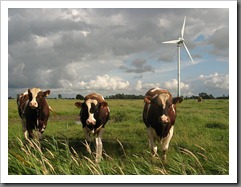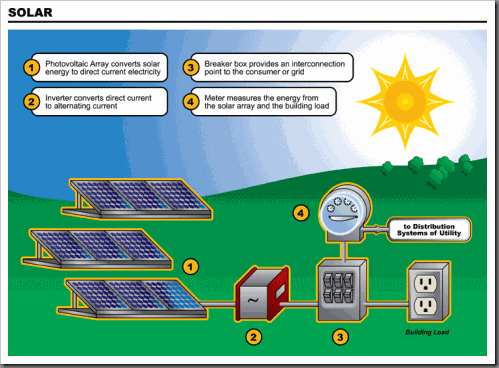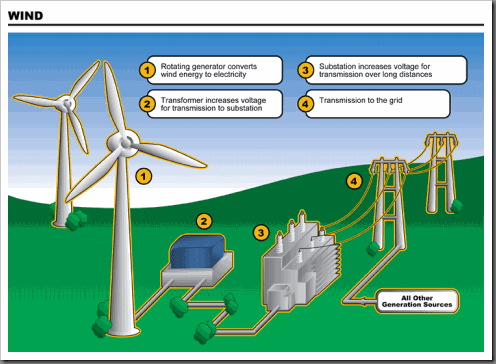Friday, November 4, 2011
Thursday, November 3, 2011
Wednesday, November 2, 2011
Tuesday, June 29, 2010
Wednesday, June 23, 2010
Many of us have a lot of questions about the efficiency of renewable energies. What is the difference in results from Solar, Wind, Wave, and Geothermal technologies? In my own very particular way of understanding I had to compare, get deep, find humor, draw pictures, watch videos, research companies and ask ‘WHY THE HECK AREN’T WE DOING THIS ALL THE TIME?” But the answer to that was fairly simple. Here’s the breakdown of the different kinds of energies available to us (not you and me, necessarily, but as a human race) to tap into.
1. Solar: 1000 watts per meter squared
2. Wind: 10,000 watts per meter squared
3. Wave: 100,000 watts per meter squared
1. Solar:
Types:
Active – includes photovoltaic panels & solar thermal collectors to harness energy
Passive – using building orientation, building materials, light dispersion, and air circulation to result in favorable living/working conditions in a building.
a. Potential to provide over 1000x the total world energy consumption in 2008.
b. Intermittent energy source (not available at all times, yet fairly predictable)
c. Accounts for most of the renewable energy on Earth
d. Only a miniscule of the available amount is actually used, and it is limited only my humans’ abilities.
e. Lack of national strategy to get it going, even after mounting climate concerns and oil spill
f. It would give the U.S. energy independence, which would provide price stability.
Helpful websites:
1. Planet Green – Saving money on solar panels. http://planetgreen.discovery.com/tech-transport/save-money-solar-panels.html
2. Solar Cooker – Useful for being sustainable with sun-charged food and for camping - http://www.solarcookers.org/catalog/
2. Wind:
a. Uses wind turbines, mills and pumps
b. Use worldwide has doubled in the past three years, mostly due to government subsidies
c. Use of energy from wind power in Denmark is 19% and in Spain and Portugal is 13%. 80 countries in 2008 used it on a commercial basis.
d. It is plentiful, clean, has no emissions, is widely distributed and renewable.
e. One small issue: possible leaking of fluids may contaminate water supply in worst case scenario (ie. not well-maintained while operating)
f. Farmers commonly lease land to farms and cattle will graze as though nothing has changed. Agriculture is also unaffected. A win-win situation for both (farmer makes money, from $3-5.000 a year per turbine, while not having to change anything, and wind-turbine operators just have a lease, not having to own or tend the land)
3. Wave
The Ocean is a huge energy storage system – naturally, when people started to understand this, they wanted to transfer that energy for their own use. Because the lunar currents can be predicted up to 100 years in advance, while wind currents can be predicted by 5 days before, they are very predictable.
1. Wind power uses the transport of energy in ocean currents to generate electricity.
2. Waves are caused by the lunar pull or by the win flowing over the surface of the ocean.
3. There are challenges to wave-technology. The equipment has to endure storm damage and corrosion, making it very costly and possibly destructive to the aquatic environment.
4. The cost of wave energy is relatively high.
5. The noise levels of the instruments vary greatly, but there are a few that are very loud, and noise pollution could prove destructive to marine life.
6. Wave farms could interfere with commercial and recreational fishermen and prove dangerous for sea navigation. Most of the instruments are both above as well as below the surface.
7. There is currently very limited funding in the U.S. in particular and many state and federal regulations in place in the case of land use.
Sources:
1. Wikipedia. wikipedia.org/wiki/solar_power
2. Linn, Allison. “Solar Struggles in U.S. Market.” msnbc.com. June 14, 2010. June 15, 2010. <http://www.msnbc.msn.com/id/37623433/ns/business-us_business//>
3. Krupp, Fred. Earth: The Sequel. New York, NY: Norton & Co, 2009
4. Wikipedia. wikipedia.org/wiki/Wind_power
5. Wikipedia. wikipedia.org/wiki/Environmental_effects_of_wind_power
6. Wikipedia. wikipedia.org/wiki/Wave_power
Friday, June 4, 2010
We all know someone with a Prius, who like to brag about how they can use the HOV-lane on the freeway in rush hour and how they get 40 MILES TO THE GALLON!!! We all know about Leonardo smugly showing the world that he cares, and we all know that there was a waiting list for Priuses for quite a while. Yup. We’ve even rolled our eyes at the bumper sticker on the back of one that says “ My car starves terrorists. WHAT DOES YOURS DO?”
1. Yes, they are lower on their emissions, and yes 40 to 60mpg is quite good.
2. They use electric batteries that power electric motors. The engine (a combustion engine like in a regular car) generates electricity to charge the battery when you accelerate too fast, but if you’re going slow no gas is being used.
3. Contrary to common perception (started by a rumour from.. well those who have a lot to lose from less gas consumption), they do handle just as well as a gas-powered car (*ahem* EXXON) AND they won’t have you stranded on the highway, unless you ran out of charge AND gas, in which case, it’ll happen just as easy in a regular car, and it’s less about the car and more about you paying attention.
4. The controversy: The mining of the materials in the batteries is extremely damaging to the environment, and the substances used to power the batteries are extremely poisonous to people, animals and nature.
Sure, they may save you a juuuuust noticeable amount in your account from gas, but being very pricey and toxic to the environment, you may want to wait a few years until technology and the infrastructure allows for fully electric cars to be more easily purchased and used. Otherwise, buy one, be a smug Prius owner and go get yourself a Co-exist bumper sticker or the one that says “ Chicks dig a man with a big Prius” to slap on the back of it, but, make yourself feel even better by making sure that when it is time for little ole Betsy to kick the bucket, that it is a hazardous waste bucket and disposed of in an eco-friendly way.
-Alexandra Bwye-
For Co-Opera
Sources:
1. http://www.automotoportal.com/article/all-you-need-to-know-about-hybrid-cars
2. http://www.driversense.com/driversense/column/369
3. Uliano, Sophie. Gorgeously Green. New York, NY: HarperCollins, 2008
4. Krupp, Fred. Earth: The Sequel. New York, NY: Norton & Co, 2009








